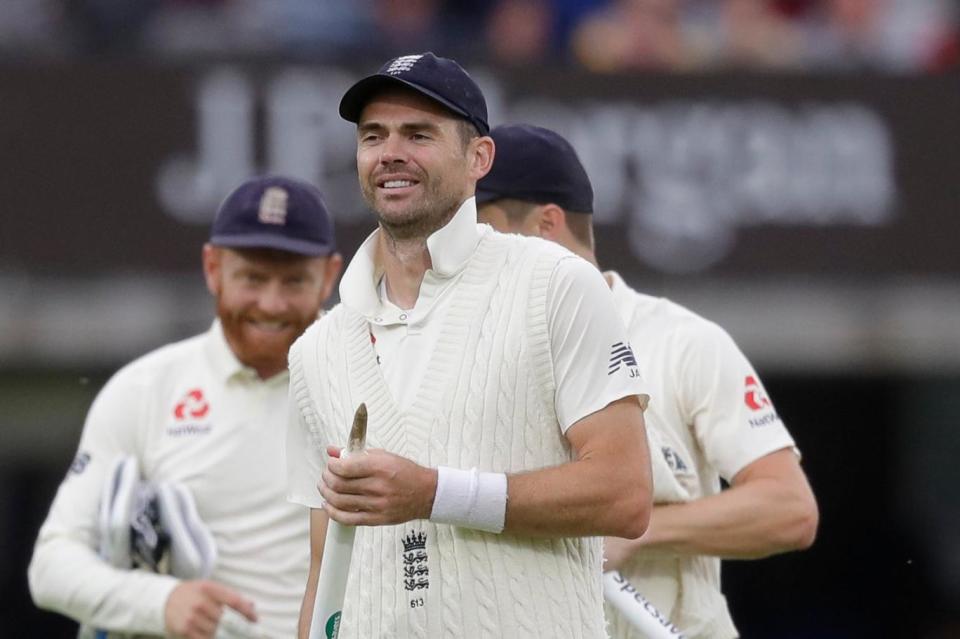England seamer James Anderson has the body to keep going into roaring 40s

The accepted wisdom and public pronouncements have, for some years, suggested that the 2019 Ashes would be James Anderson and Stuart Broad’s last international hurrah.
Anderson will be 37 and Broad 33. Both, at one stage or another, are on record saying they are not looking beyond that series. Both have started looking to life beyond the boundary and in the commentary box, where both were impressive this summer with TMS and Sky respectively. Anderson changed agents specifically for that reason.
Both have managed injuries and, if they make it that far, they will have close to 300 caps and well over 1,000 Test wickets between them, which is surely enough to leave even the hungriest — and these two are hungry — sated.
And yet, as they head from one happy hunting ground — Lord’s — to another, Trent Bridge, it seems worth wondering if next year really does need to be it for England’s leading wicket-takers. Trent Bridge, depending on which you ask, is the home of Broad’s eight for 15 and average of 20 or Anderson’s average under 19 and twin 10-wicket hauls.
Both have bowled superbly as England have gone 2-0 up against India. Typically, Anderson’s excellence has been relentless, consistent and beautiful. Broad has been classically wild, popping up in special, vital spells in both second innings: at Edgbaston, he got the openers; at Lord’s, he gutted the middle order. 2017 was his worst year in Tests since 2009, but Broad averages 24 in 2018. His average pace, 84.3mph, is higher than it has been since 2011, too. Twice this year, in Auckland and Edgbaston, it has been suggested he should lose the new ball. Twice, he has responded in style.
Still, the sense is that Broad is likelier to finish next year. His action is more taxing and, while four years younger, more of his work came early. Anderson, as he struggled with his confidence and action, played in 18 Tests before turning 25 (averaging 38), whereas Broad played in 37. The end of next summer would be a normal age for a fast bowler to retire: none of England’s 2005 Ashes attack made it to 32, his age now.
Which brings us to Anderson, a marvel and a freak, whose nine wickets at Lord’s leave him just 10 shy of Glenn McGrath’s 563 Test wickets, the most by a seamer. Evidence suggests he is only improving.
Anderson in numbers
553
Test wickets for Anderson — fifth on the all-time list.
11
wickets to pass Glenn McGrath’s 563, the record for a Test seamer.
26
five-wicket hauls.
700
a realistic target of wickets if he plays until 40 — he has taken around 35 a year so far.
7
five-wicket hauls in Nottingham, his best ground for five-fors and venue for the Third Test. He has 60 wickets there at 18.95.
2
of his three 10-wicket match hauls were at Trent Bridge, as were his best figures of 11 for 71 v Pakistan (July 2010).
In 30 Tests since the start of the tour to South Africa in 2015-16, he has 127 wickets at 19.7. That includes 4-0 series defeats in India and Australia and 73 wickets since his 35th birthday at nearly five per match. This week, he topped 900 points in the ICC rankings. With 898 first-class wickets to his name, could he be the last Englishman to 1,000?
England head coach Trevor Bayliss reckons he could play until he is 40, and England’s strength and conditioning coach Phil Scott does not disagree. “We have discussed this for a long time and it really is down to him,” he says.
Scott says there are many contributing factors to his longevity. Talent and dedication are prerequisites. A decade on a central contract and a keen understanding of his body — by England’s management and Anderson — have been as vital, as has his smooth action.
“Fast bowling is a massively impactful exercise,” adds Scott. “A few years ago, when he was tested on force plates, the load he put through his body at the crease is a lot less than the average. Jimmy was around four times his bodyweight on the front foot at contact. Research shows it can be as high as 12.
“He’s got the physique and is an athletic mover. He has never carried excess weight, which makes a massive difference over 10 years.”
In two months between the Pakistan and India series, he played just six days’ cricket, only three first-class, as he managed a long-term shoulder complaint. Before each game, he would work on the outfield with Scott.

“The work we do is Jimmy-led,” says Scott. “He knows his body better than anyone. The bonus is that he plays no one-day stuff, which gives us a very controlled way of building up to Test loads.”
There were whispers Anderson could miss a tour this winter, although he is unlikely to want that and there will be fears that if he stops for long, restarting could be a struggle.
“He has to keep that engine running,” agrees Scott. “I’ve worked with him for four years and he’s known he wants to prolong his career.”
This summer, Broad and Anderson’s excellence has made England’s last three Tests shorter and increased their chances of lasting longer. Predicting the end has seldom seemed so unwise.

 Yahoo News
Yahoo News 